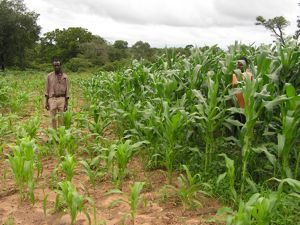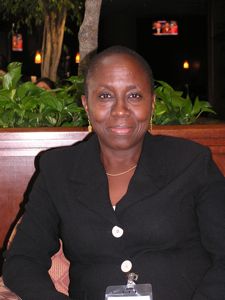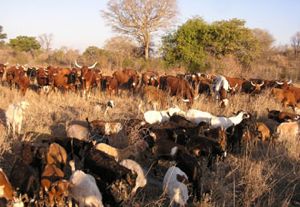Reversing Desertification
Air Date: Week of June 4, 2010

No cattle grazed the plot on the left. On the right, hooves broke up the soil and animal waste provided fertilizer. (Photo: Africa Centre for Holistic Management)
The winner of this year’s Buckminster Fuller Challenge is an initiative that helps transform packed dry grasslands and savannahs into water-rich pastures. Operation Hope promotes managed cattle grazing, a technique that contradicts conventional beliefs on the effects of animals and soil preservation. Host Jeff Young talks with Allan Savory, founder of the Africa Centre for Holistic Management and the Savory Institute and Professor Zakhe Mpofu, special advisor to the Zimbabwe project.
Transcript
YOUNG: Conventional wisdom has it that cattle are bad for the land. They pack soil so hard that plants can't grow. But sometimes what we think we know, isn’t necessarily so.
A non-profit working in Zimbabwe is using livestock to bring dry, denuded, desertified land back to life. The Africa Center for Holistic Management just won the Buckminster Fuller competition. It rewards those who apply Fuller’s famously unconventional thinking to environmental problems. Professor Zakhe Mpofu and wildlife biologist Allan Savory developed the Center’s livestock land remedy. Welcome to Living on Earth!
MPOFU AND SAVORY: Thank you.
YOUNG: So isn’t desertification driven by over-grazing? How can cattle be part of a solution when we’ve been thinking they’re the problem?
SAVORY: Yes it’s in the public media and the myths and so on, livestock cause desertification and they have historically. And I used to condemn them totally until I found from my own research that I was wrong. Now I defend a completely different position. Livestock are the only tool available to science with which to reverse desertification. It depends how you manage them, how you run them.

Wildlife biologist and farmer Allan Savory developed the idea of brief cattle grazing to mimic wild grazers on the savannah. (Photo: Savory Institute)
YOUNG: Professor, help us understand a little more how this actually works. How do you keep the animals where you want them?
MPOFU: We keep the animals by having the herders keeping them where we actually want them, following the plan that has been devised. Because we planned two times a year, right at the beginning of the growing season. We planned for the growing season and we planned for the dry season. So that the herders then follow the plan that has been drawn.
SAVORY: When we realized we had to mimic the animals we also realized we had to have some planning process that could treat each situation as unique. So we actually train people very simply to get the livestock in the right place for the right time for the right reason and to keep them bunched, in their bunching behaviors, though predators were around.
And our cattle, if you can picture this, are over night in lion-proof, predator-proof corrals. Because we are predator friendly in what we are doing, we want the predators. And then during the day they are herded to a plan and the herders just herd them very, very calmly in a bunched manner. And that plan leads to no plants or soil on our land being exposed to the animals for more than 3 days—ever—and then not re-exposed for 6-9 months.
YOUNG: But what’s different about the use of land by cattle who are bunched together versus those who roam more broadly?

Professor Ntombizakhe Mpofu directs research at the Africa Centre in Zimbabwe. (Photo: Savory Institute)
MPOFU: The animals that are bunched together, what they do is they are bunched together, they chip the land, the soil becomes loose. It allows air to get into the soil. It allows rain to soak in as when the rain comes. So what we have done now is to turn almost desert lands into thriving grasslands.
SAVORY: The Dimbangombe Ranch that Zakhe and the others are managing and running is a microcosm of the biggest problems in the world: poverty, violence, droughts and floods-almost perennial now. Now, what we’ve done there is to return it to animal-maintained rather than rest and fire grasslands and savannah.
So we’ve increased the livestock four times and because of that we now have an abundance of grass, even in a dry year we’re not worried at all about drought and forage production. And we now have open water with water lilies, fish a mile above where we’ve ever known water historically in the river system, right through the dry season.
YOUNG: It kind of makes you wonder why people haven’t been doing it this way before. Why do you think it took so long to discover this way of doing something as elemental as herding cattle?
MPOFU: My background, personally, is in animal science- I’ve trained in animal science. And I looked at it and said to myself, ‘it looks too simple to be true’.
YOUNG: Uh huh.
MPOFU: And that’s what it is. And, that’s why I think most people have been skeptical and said even said, ‘Prove it- whatever it is you are saying works, let’s see you proving it’.

No cattle grazed the plot on the left. On the right, hooves broke up the soil and animal waste provided fertilizer. (Photo: Africa Centre for Holistic Management)
YOUNG: What has participating in this meant for you?
MPOFU: It has meant quite a lot for me because I have seen how communities can be changed. Their lives can be changed because if you look at this, in this issue, there is the productivity of the land, there is the productivity in terms of livestock production, but there is also environmental issues as well as economic and social issues. In this program what fascinates me about it a lot is it also has social aspects which most people don’t consider. You look at communities these women and children who are affected by this program, one the main outputs of it is the improvement in water.
YOUNG: In water?
MPOFU: Yes. As the rain comes, because the ground is covered, more water soaks into the ground. As it soaks into the ground, the water level goes up. And water is a big issue in the rural communities. Women walk distances with their children to go and fetch water.

Cattle spend only three days on a patch of desertified soil. (Photo: Africa Centre for Holistic Management)
As the land improves more water becomes available, and then the labor of fetching water from long distances becomes not an issue anymore. So it’s not only about land, it’s about land and people. So you have an issue of increasing crop productivity. You have water. And this is all in terms of contributes in terms of reducing poverty. So it looks like we have an answer for Zimbabwe and for the world, really.
[MUSIC: Hugh Masakela “Grazin In The Grass” from Live At The Market Theater (Four Quarters Records 2007)]
YOUNG: Professor Zakhe Mpofu is a special advisor to the Africa Center for Holistic Management. Allan Savory founded the Savory Institute for Holistic Management. There’s more on their project at our website, loe.org
Links
Living on Earth wants to hear from you!
Living on Earth
62 Calef Highway, Suite 212
Lee, NH 03861
Telephone: 617-287-4121
E-mail: comments@loe.org
Newsletter [Click here]
Donate to Living on Earth!
Living on Earth is an independent media program and relies entirely on contributions from listeners and institutions supporting public service. Please donate now to preserve an independent environmental voice.
NewsletterLiving on Earth offers a weekly delivery of the show's rundown to your mailbox. Sign up for our newsletter today!
 Sailors For The Sea: Be the change you want to sea.
Sailors For The Sea: Be the change you want to sea.
 The Grantham Foundation for the Protection of the Environment: Committed to protecting and improving the health of the global environment.
The Grantham Foundation for the Protection of the Environment: Committed to protecting and improving the health of the global environment.
 Contribute to Living on Earth and receive, as our gift to you, an archival print of one of Mark Seth Lender's extraordinary wildlife photographs. Follow the link to see Mark's current collection of photographs.
Contribute to Living on Earth and receive, as our gift to you, an archival print of one of Mark Seth Lender's extraordinary wildlife photographs. Follow the link to see Mark's current collection of photographs.
 Buy a signed copy of Mark Seth Lender's book Smeagull the Seagull & support Living on Earth
Buy a signed copy of Mark Seth Lender's book Smeagull the Seagull & support Living on Earth

